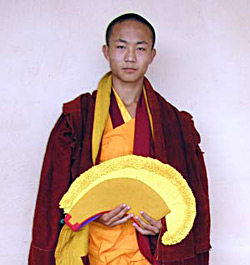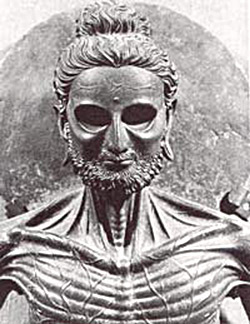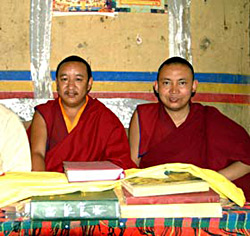What is a Monk?

A monk of SeraSe ra-India
If the ancient, classical sources are right, in his mid-twenties the Buddha renounced the life of pleasure and affluence. He cut off his hair, became an ascetic, and entered the forest, where he lived with other men – śramaṇas – who were engaged in the practice of austerities and meditation. After six year of practicing a severe form of asceticism that included rigorous fasting, the Buddha realized that this type of discipline was as much of an extreme as the life he had renounced. He took nourishment, and regaining his bodily strength, he meditated until he attained enlightenment. Shortly after his enlightenment, the texts tell us, the Buddha established an order of monks, and eventually an order of nuns. Applying the lessons he had learned in the earlier periods of his life, he created over his lifetime a discipline – the Vinaya – that would come to govern the life of the Buddhist clergy: a discipline that the Buddha considered a middle way between the extremes of sensual indulgence and self-mortification.
Motivated by a sense of disgust with the conditioned world and its sufferings, and by the realization that no lasting happiness is to be found in worldly pleasures, Buddhist monks and nuns are those individuals who emulate the Buddha by abandoning the life of sensual enjoyment. In place of a life dedicated to the pursuit of pleasure, they give themselves over to a life of discipline and restraint, realizing that this is conducive (some Buddhist schools would say necessary) to achieving a more lasting happiness, the permanent peace of nirvana. Disgust with the world, or renunciation (ngenjungnges ’byung) – an attitude that TsongkhapaTsong kha pa likens to the attitude of prisoners who can think of nothing else but release from their incarceration – is, strictly speaking, a necessary condition for entering the monastic life. In practice, however, few individuals probably entered monasteries with an already developed and mature sense of renunciation.

A second century C.E. Gandharan statue of the Buddha during the ascetic phase of his life. From Heinz Bechert and Richard Gombrich, The World of Buddhism (London: Thames and Hudson, 1984), 42.
In Tibet, most monks were ordained at an early age before they were even instructed in religious principles. They entered the monastery with an attitude that was probably more akin to that of children about to attend summer camp. Many of these children probably had little deeply felt devotion to the religious life, at least initially. They entered the monastery simply because this was the wish of their parents. Those few who made such a choice at a more mature age may have entered for religious reasons, but as often as not they may have entered simply to escape the responsibilities that came with traditional family life. It is not surprising that young men should have sought monasticism as a lifestyle, or that parents should have wanted such a life for their sons. In Tibet, a monk’s life was financially more secure than that of the typical villager, it afforded one a greater opportunity for education, and it sometimes opened the door to civil service positions in the Tibetan government.1 As in most Buddhist countries, monasticism in Tibet became institutionalized, and the monastic life was for many a profession. This does not mean that some monks did not go on to develop a profound sense of religious vocation, and even a deeply felt sense of renunciation, over the period of their lives. The historical records clearly show that the monasteries produced great saints, individuals who saw the world and its activities as vanities, but these were always in the minority, and even in these cases, such an attitude was something that developed and grew over a lifetime.

Novice monks of SeraSe ra-India.
Formally speaking, a monk or nun is any individual who has taken monastic vows in a Buddhist ordination ceremony.2 Practically speaking, in Tibetan culture, a monk is any male3 with one of three forms of ordination:
- renunciate (rapjungrab byung)4
- novice (getsüldge tshul)
- full ordination (gelongdge slong).
Renunciates take the five basic vows of a layman,5 supplemented by a few additional vows that require them to adopt certain monastic behaviors: for example, shaving their heads and wearing robes. Novices take ten vows (sometimes further elaborated in a list of thirty-six).6 Fully ordained monks in the Tibetan tradition take 253 vows.7 All forms of monastic ordination in Tibet are presumed to be for life, even if there exist mechanisms that allow monks and nuns to return their vows – and hence to return to lay life – if they so choose.8 A young boy can take novice ordination when he is old enough to successfully “scare away crows” (about age seven). To take full ordination, one must be at least twenty years of age. The higher levels of ordination require the lower levels as prerequisites. Hence, one must take novice vows before taking full ordination, and one must take lay vows before taking novice (although all of the ordinations can take place within a single day).

Two fully-ordained monks at SeraSe ra-Tibet. Today monks of this age are among the most senior monks of the monastery.
Any official member of SeraSe ra is required to have one of these three forms of ordination: renunciate, novice, or full. Typically, young boys take renunciate ordination when they first enter the monastery (either SeraSe ra or the monastery in their home region). They may remain at this level of ordination for several years until their teacher decides that they are ready to take novice vows. Since textualists who planned to complete their studies and to obtain the geshédge bshes degree had to study the Vinaya, and since the study of the Vinaya required that the monk have full ordination, all serious textualists eventually received full ordination. There were some monks, however, who remained novices their whole lives. Obviously, these were mostly workers (and not textualists). Novice and full ordination ceremonies would usually take place en masse from time to time, and the great scholars and highest lamabla mas of the monastery (or of the GelukDge lugs tradition) usually served as the abbot (khenpomkhan po)9 on these occasions.
People Home
Table of Contents
- What is a Monk?
- The Vows
- The Vinaya
- Hierarchy and Status
- Contemporary Distinctions
- Demographics
- The Sera Monks Archives
- Glossary
- Notes
- Specify View:
- Specify Format:
 |  |  |